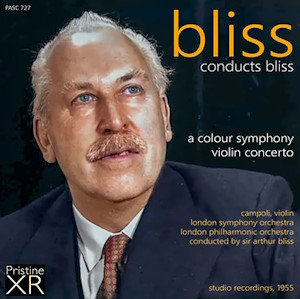
Sir Arthur Bliss (1891-1975)
Bliss Conducts Bliss
Concerto for violin and orchestra, F111 (1955)
A Colour Symphony, F106 (1921-1922, rev. 1932)
Alfredo Campoli (violin)
London Philharmonic Orchestra (concerto), London Symphony Orchestra (symphony)/Sir Arthur Bliss
rec. 9-11 November 1955 (Concerto); 23-24 November 1955 (Symphony), Kingsway Hall, London, UK
Pristine Audio PASC727 [69]
There have been several reissues of Arthur Bliss’s Violin Concerto and A Colour Symphony, conducted by the composer. (I was introduced to both on the old Decca Eclipse label; it had remarkable covers, usually depicting a National Trust property.) These date from the early 1970s. The original monaural recordings were made in November 1955.
A Colour Symphony was Bliss’s first major orchestral work; he revised it a decade later. It was premiered at the Gloucester Three Choirs Festival on 7 September 1922, to mixed reviews.
The symphony, inspired by the symbolic meanings of colours in heraldry, has four movements: Purple, Red, Blue and Green. Each embodies characteristics associated with its respective color, such as royalty and death for Purple, and courage and magic for Red.
I think that colours and their connection to the listener’s enjoyment of the symphony can be safely ignored. Just enjoy it as a symphony with four contrasting movements “full of vitality and beauty”. Bliss and the LSO give an authoritative account, which holds the attention from the first note to the last.
One contemporary critic of the original LP (Decca, LXT 5170), impressed by the “exhilarating performance”, considered that “the time is long overdue for this full-blooded music to take its proper place in the concert hall beside Elgar and Vaughan Williams”. His prophecy was never to be. The last time the work was played at a Promenade Concert was in 2006.
To be sure, there are other outstanding recordings of A Colour Symphony: by Vernon Handley and the Ulster Orchestra, (Chandos 8503, 1987), David Lloyd-Jones and the English Northern Philharmonic Orchestra (Naxos 8.533460, 1996) and Richard Hickox and the BBC National Orchestra of Wales (Chandoc 10380, 2006). Even so, there is an inherent value in having Bliss’s own interpretation to hand.
At the same time, Arthur Bliss recorded his Violin Concerto and the now largely forgotten Theme and Cadenza. This time the orchestra was the London Philharmonic with the violin soloist, the Italian-born Alfredo Campoli. The LP was issued in April 1956 on Decca LXT 5166.
Bliss wrote his forty-minute Violin Concerto at a time of considerable political tension in Europe. There are three movements: Allegro ma non troppo, Vivo – tranquillo and Introduzione (Andante); Allegro deciso in modo zingaro). The overall mood of the piece is a studied contrast between lyrical beauty and dramatic passion, which seems to echo the age.
Campoli gives a splendid account of the concerto which gives him little opportunity for relaxation. He dominates the proceedings from the first to the last, playing with refinement and proficiency. There is a warmth of tone that is often beguiling. The concerto was premiered in 1939 by the present soloist with the BBC Symphony Orchestra.
Another recording of Bliss’s Violin Concerto, in 1968, once again featured Campoli and the composer but with the BBC Symphony Orchestra (BBC Classics 15656 91842, 1996). I have not heard this album. Two other recordings of the concerto have been released: by Lydia Mordkovitch with the BBC National Orchestra of Wales under Richard Hickox (Chandos 10380, 2006) and Lorraine McAslan and the BBC Concert Orchestra conducted by Martin Yates (Dutton Epoch, CDLX 7342, 2017).
The work is a significant contribution to the genre. Alongside Edward Elgar’s (1910) and William Walton’s (1939) pieces, Bliss’s essay is the third pillar of the triumvirate of great Violin Concertos composed by an Englishman. Sadly, it is rarely heard in the concert hall. Its last outing at the Proms was on 3 August 1955.
The present remastering is due to Andrew Rose, who took the original monaural edits and “dusted them down a little, [to] bring greater space and finer tone to both recordings, further enhancing two excellent examples of Decca’s mid-fifties output”. He also supplied the liner notes, which, if I am honest, are a little bit lacking. Basically, it is a concatenation of two contemporary reviews from The Gramophone magazine, with a concluding comment.
This disc is a worthy addition to the Bliss catalogue: two important works, performed under the baton of the composer. Enthusiasts will be delighted to have this superb restoration.
John France
Availability: Pristine Classical


















